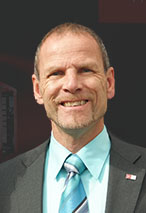Press release no. 01
SD Formentechnik relies on Zimmer & Kreim for automation
For some time, the management team at SD Formentechnik, based in Lüdenscheid, has been thinking in terms of networked process chains. When it came to electrical discharge machining, this mould maker called on Zimmer & Kreim: The Chameleon and the Alphamoduli workshop software integrate the erosion systems, as well as a machining centre for electrode milling and the measuring machine.
SD Formentechnik, based in Lüdenscheid, produces high-quality thermoplastic injection moulds, primarily for the electronics industry, but also for the automotive and packaging sectors. The business is still relatively young, having been founded in 2003. “A lot of moulds are produced for visible parts, but we also create moulds for purely technical components,” explains Jens Weigert, who is responsible for mechanical production. “We use Visi by Mecadat as a CAD/CAM system. We set up the first Visi workspace shortly after the company was founded, in order to bring electrodes in-house and establish our milling range.”
Since then, these Lüdenscheid-based mould making experts have accumulated a wealth of expert know-how. Customers value the fact that the SD Formentechnik team accompanies projects from the consultation stage, through product design, tool construction, production and matching, all the way to series manufacturing. In order to ensure that the tools arrive at the customer ready for production, the company uses a technology centre with a spotting press and with sufficient in-house injection moulding capacity, which is reserved entirely for matching the injection moulds.
More complex parts, increasing order numbers and the ever-growing pressure to meet deadlines have fuelled the company’s growth. Just seven years ago, the company’s twelve employees moved to their new location. Now, a total of 32 people work at SD Formentechnik.
Using machine capacities to the fullest
However, these new hires were just one side of the coin. On the other side, the company’s managing team were also busy making sure that the available capacity of the machines was being used to the fullest. Over ten years ago, the mould making business was already busily automating electrode production as much as possible using a Chameleon handling system.
“Back then, our main concern was to make the most of our unmanned times”
“Back then, our main concern was to make the most of our unmanned times,” explains Weigert. “Although we had equipped the cavity sinking machine we were using at the time with a sixteen-fold electrode changer, that wasn’t enough to make it through the night without any staff, let along through a weekend. The machine had a huge amount of potential that we weren’t able to use. As a result, we wanted to implement an automation solution to cover these time periods and, if possible, to connect our electrode milling and erosion machining processes.”
What’s more, customers were clamouring for ever-shorter delivery times. “We could only fulfil these requests by optimising our own process chains,” emphasises Weigert. “This also involved streamlining our lead times and designing them to be easily calculable. This included making optimal use of our machinery capacity.”
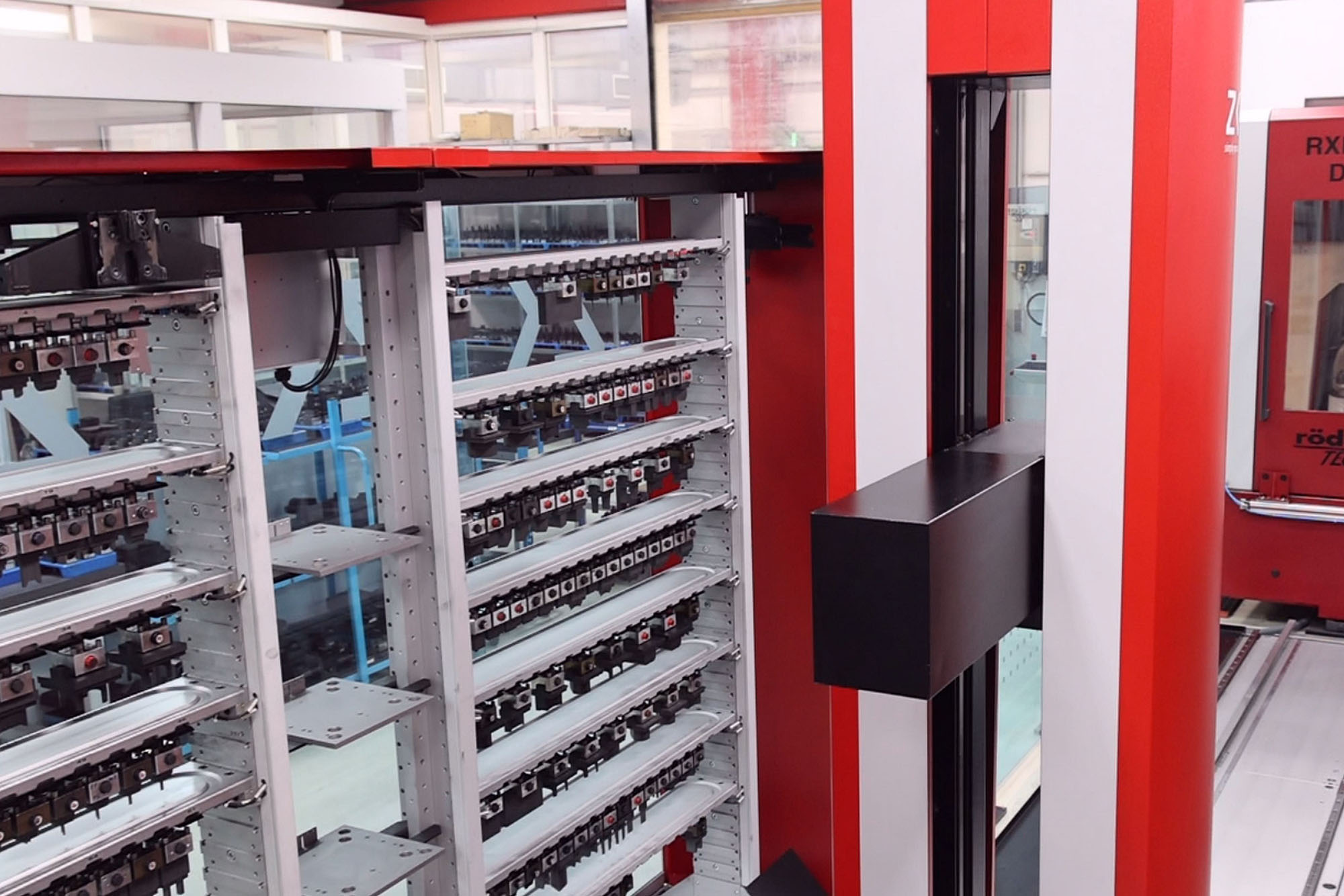 Photo: At SD Formentechnik, the Chameleon from Zimmer & Kreim links two genius EDM systems of different sizes with a Röders HSC milling machine for electrode machining and a Zeiss Vista measuring machine.
Photo: At SD Formentechnik, the Chameleon from Zimmer & Kreim links two genius EDM systems of different sizes with a Röders HSC milling machine for electrode machining and a Zeiss Vista measuring machine.
Zimmer & Kreim takes on responsibility for the entire system
Weigert’s team looked at a number of different systems and researched the advantages of each in detail. In the end, they opted for a Zimmer & Kreim system. “One key point was that our machining centre, which we were using for electrode milling at the time, could be integrated into the automation solution,” says Weigert. “The unique benefit that Zimmer & Kreim offered was that their automation specialists took on responsibility for the entire system, which included the integration of the milling machine.”
Another point in Zimmer & Kreim’s favour was the modularity of the system, which would yield greater advantages in the event of subsequent expansion. After all, the signs were all pointing towards continued growth and the management at SD Formentechnik wanted to keep all their options open to enable further development.
“From the very beginning, Zimmer & Kreim took responsibility for every aspect of automation. Their experts took care of every interface and every connection required for our machines.”
As a result, it was down to the Brensbach-based experts to configure the entire system optimally, create the required interfaces and get the system up and running. “There were no cases of shifting responsibility to others, as is sometimes the case when you try to handle automation yourself, or if the automation specialist isn’t responsible for the entire system,” says Weigert, explaining one advantage of this process. “From the very beginning, Zimmer & Kreim took responsibility for every aspect of automation. Their experts took care of every interface and every connection required for our machines.”
Implementation of automation
In any case, the automation process did not begin with the Chameleon. “We took our time – over a year in total – in order to evaluate the individual systems and manufacturers, and ensure that our processes were ready,” explains Weigert. “First, the sequences need to be right. It makes no sense to implement automation if anything sub-optimal remains. Otherwise, you inevitably end up automating all the weak spots in the existing sequences as well, meaning that the machines will continue to implement any errors currently present in the processes. It is essential to consider any planned automation down to the finest detail before any work is done. This way, you can than make real use of the benefits it brings.”
This is where the experts from Zimmer & Kreim put their know-how to use, advising and accompanying the SD Formentechnik team during the preparatory stages and beyond, and using their expertise to help make the processes ready and suitable for automation. An expert, outside perspective on the processes within the company paid off, helping the management team to prepare the structures efficiently for automation.
Investing a little more time in planning and preparation is definitely worth it. As a result, all processes at SD Formentechnik were put to the test and optimised from a holistic perspective, even before the first signs of automation arrived at the mould manufacturer’s premises. This also included the electrode construction – some electrodes, for instance, are now constructed differently, in a manner that has been tailored to suit the advantages of automation.
In the end, the first steps towards automation were taken while the company was still based at its old location, using an existing Zimmer & Kreim genius 601 cavity sinking machine, the Chameleon handling system, the Röders RXP600DSH, the Zeiss measuring machine and a shelf element. At the time, this was enough to meet the company’s needs. This configuration was even able to extend the unmanned running times of the machine by a significant amount. Integrating the milling machine also provided a much higher level of autonomy in the system.
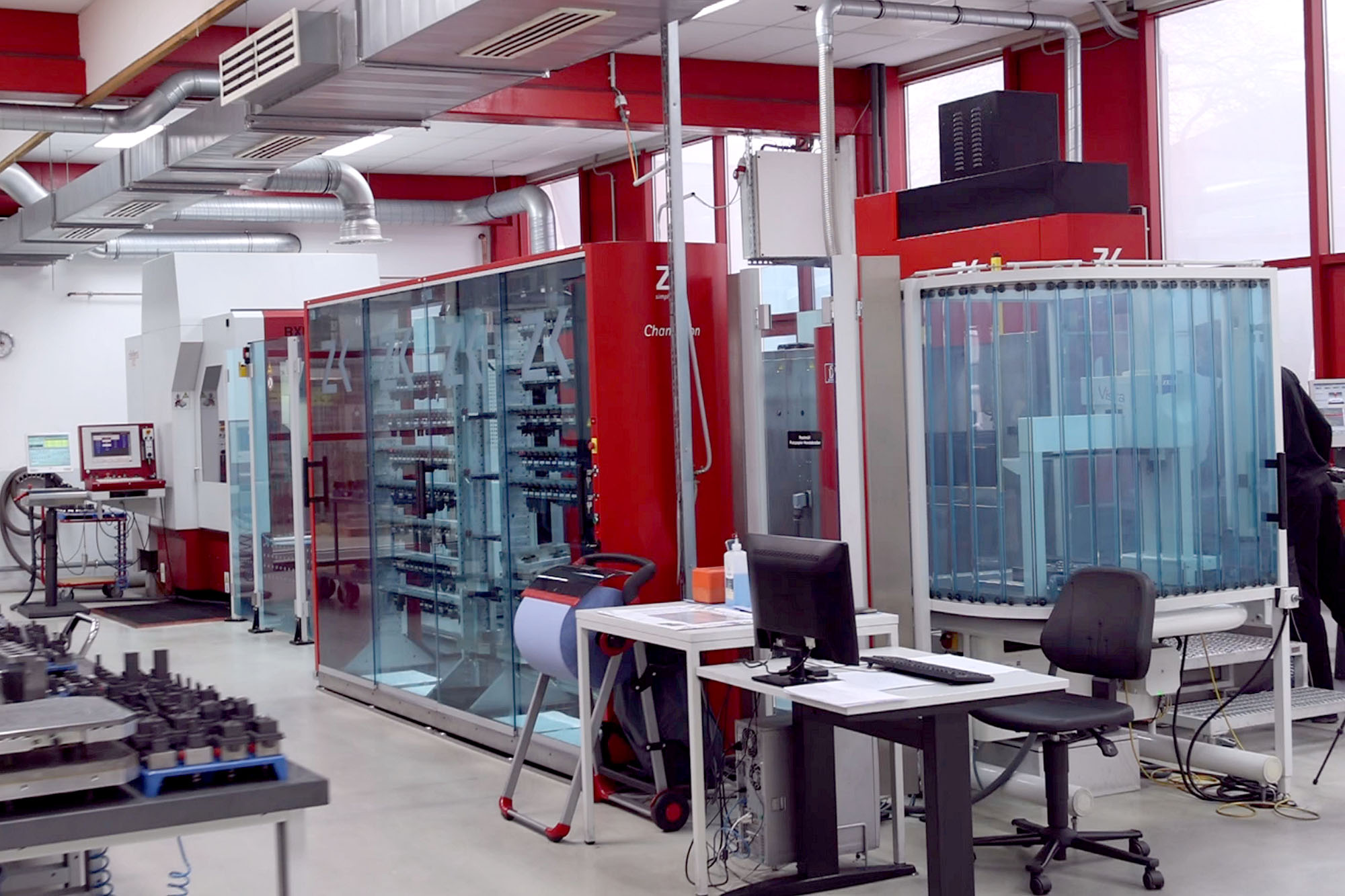 Photo: Automation enables unmanned work around the clock, even on weekends. The Zeiss Vista is positioned in the foreground, at the front of the system.
Photo: Automation enables unmanned work around the clock, even on weekends. The Zeiss Vista is positioned in the foreground, at the front of the system.
The automation grows with the needs of the company
After the company’s relocation in 2014, its original milling machine made way for a higher-performance Röders RXP 600 DSH HSC machining centre. “We added a Zeiss Vista measuring machine for measuring electrodes and workpieces,” remembers Weigert. “Since then, it has become responsible for around 95% of the presetting work and measuring the precise geometry of the electrodes. This enables the system to work with real, up-to-date data.”
“We no longer have any problems using the full capacity of our machines around the clock, including at weekends”
Alongside the increase in order numbers and ever-growing scale of the individual projects, the system continued to expand. Today, a second, significantly larger, Zimmer & Kreim genius 1000 cavity sinking machine has opened up new opportunities for eroding in larger-scale dimensions. Even the shelf space has been extended considerably; currently, the shelves can hold 190 electrodes and 11 workpieces weighing up to 80 kg and measuring up to 350 x 350 mm.
They are filled using the loading station. “We no longer have any problems using the full capacity of our machines around the clock, including at weekends,” Weigert points out. “We only work with specialists. Two operators ensure that the system has something to work on 24/7.” They look after each of their projects from the very beginning through to production of the finished part, design the process accordingly, construct the electrodes, and deal with all aspects of the milling and cavity sinking programs.
Automation makes the operator’s work significantly easier
“The Alphamoduli software, which controls the system, is another huge advantage,” says Weigert. “The beauty of this solution is that everything still comes from a single supplier – and Zimmer & Kreim know their software inside and out. This means that the software is incredibly user-friendly, easy to understand and intuitive to get to grips with.” Just one week of on-site technical training was needed in order for the operators to get to work, with Zimmer & Kreim on-hand to provide support if required.
The work has changed – the processes performed on the machine are, of course, not dependent on the operator’s presence. Additionally, they follow a pattern that has mostly been standardised. Overall, the operators are united in their agreement that this has made their work significantly easier.
“It is predominantly the tedious routine tasks that no longer need to be done”
Previously, the operators would need to change the blanks by hand during the milling process – a step now performed by the Chameleon. “It is predominantly the tedious routine tasks that no longer need to be done, ” Weigert explains. “Our staff are all huge fans of the Chameleon.
Lifting the workpieces onto the measuring machine, for instance – that’s a task nobody misses. “Workpieces weighing 30 or 40 kg couldn’t be lifted alone. Previously our staff would have to find a colleague to help them lift these workpieces,” remembers Weigert. “Now, this step is another part of the system. The Chameleon does all the handling.” The automation process has meant no compromises in terms of the quality of the workpieces. Rather, the opposite is true – the continuously meticulously planned sequences are tailored to produce high-quality components. And this is exactly what they do, in an almost entirely automated process.
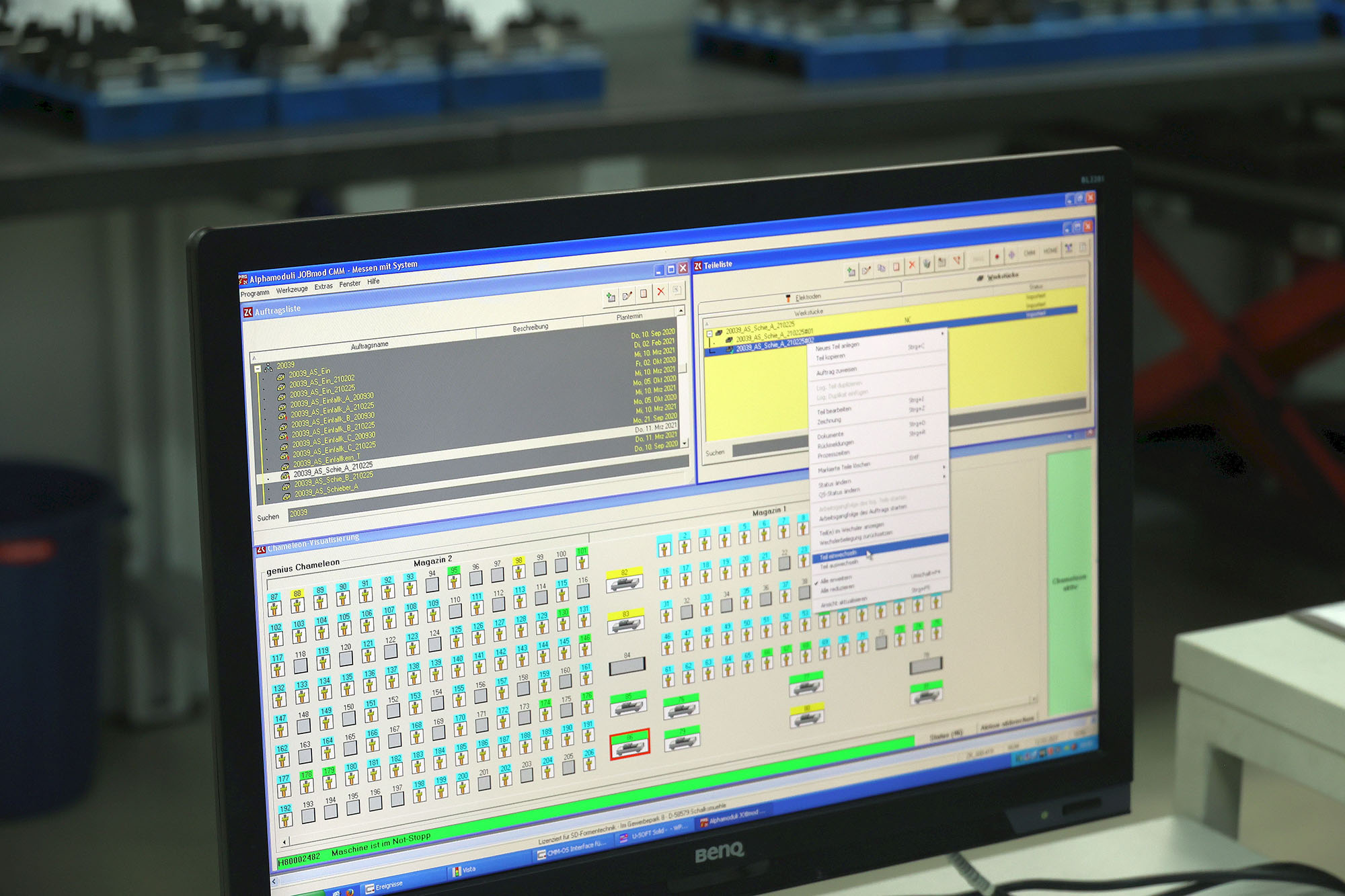 Photo: Simple and incredibly intuitive to use: The Alphamoduli software from Zimmer & Kreim can be precisely adjusted to meet the current needs of an automation system. The user benefits from the system’s modular design, which can be flexibly adapted in the event of changes and expanded alongside the system.
Photo: Simple and incredibly intuitive to use: The Alphamoduli software from Zimmer & Kreim can be precisely adjusted to meet the current needs of an automation system. The user benefits from the system’s modular design, which can be flexibly adapted in the event of changes and expanded alongside the system.
Automation with maximum flexibility
The system has also remained just as flexible; in the event of last-minute orders, operators can choose whether to add this order to the production process via the system or intervene manually. In either case, current orders can be interrupted and the urgently required parts can be slotted in seamlessly before the interrupted workpieces are then replaced and machining resumes from the same point. The priorities of existing orders can be adjusted in just a few clicks of a mouse, as can preset values
“The layout of the automation solution also makes it possible for us to easily load the machine manually, if necessary, without causing any conflicts with the automation,” continues Weigert. “This is sometimes the case for workpieces that exceed the maximum weight or size for automatic handling, for instance for the large genius 1000 EDM machine. While the Chameleon usually accesses the machines from the side, the operator can load workpieces from the front, as they usually would.”
Although “usually” isn’t quite the right word, as he goes on to explain: “Manual interventions of this kind have become real exceptions in our work. This means that they are no longer part of our employee’s daily routine, so when these situations arise, they require an extra level of concentration and care.”
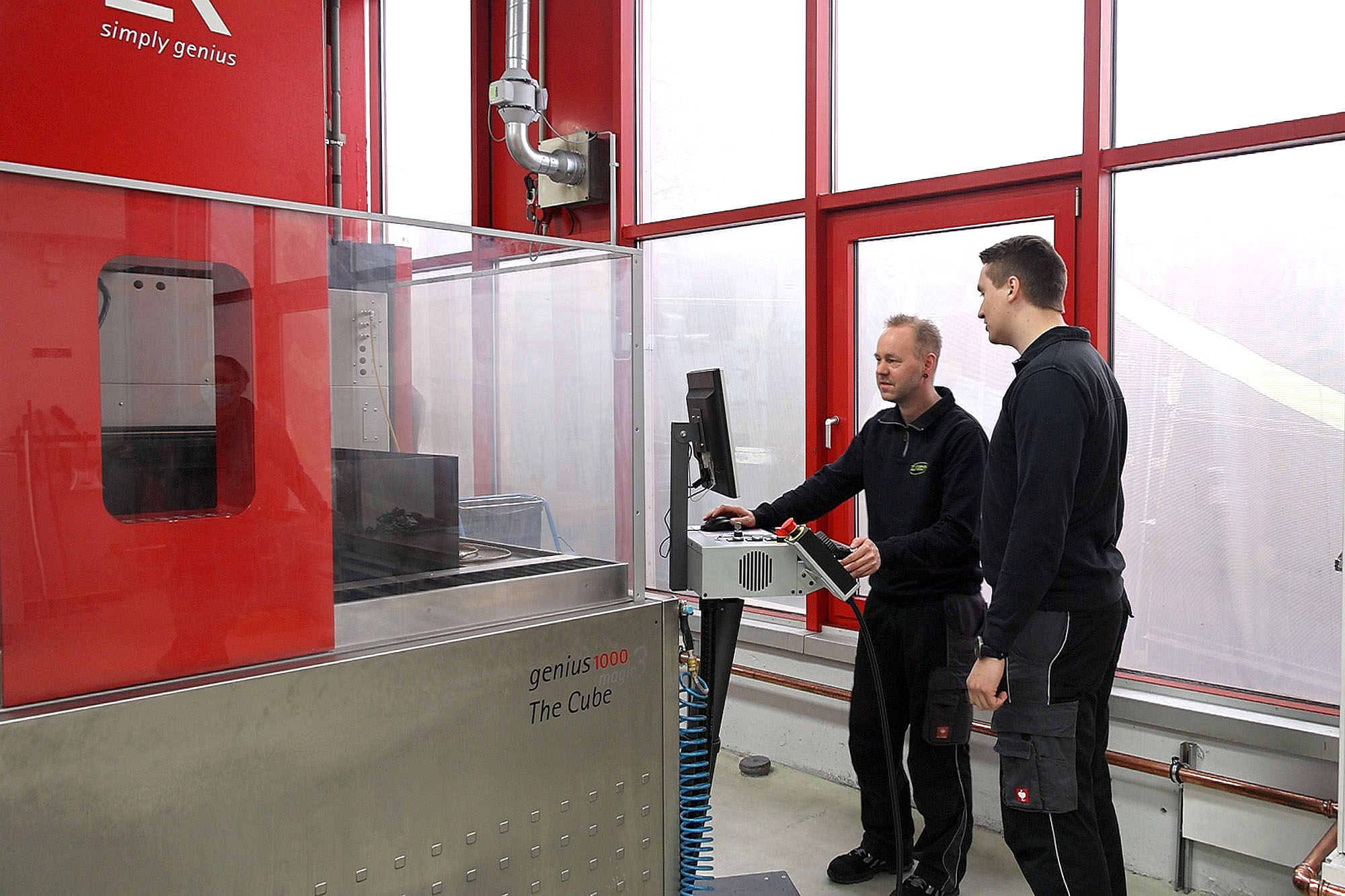 Photo: The system can even handle urgent orders with no problems. In just a few clicks of a mouse, the operator can interrupt an order, use the machine to work on a different item in the meantime and, finally, resume the original order from the exact point when it was interrupted – with no compromises on quality.
Photo: The system can even handle urgent orders with no problems. In just a few clicks of a mouse, the operator can interrupt an order, use the machine to work on a different item in the meantime and, finally, resume the original order from the exact point when it was interrupted – with no compromises on quality.
Shorter lead times and safer processes
The company’s lead times have been significantly shortened. “What’s more, we have greatly improved our ability to meet deadlines,” adds Weigert. “Another benefit is that automated sequences eliminate human error as a potential source of problems.” The Alphamoduli software tracks electrodes and workpieces using their RFID chips. “We have attached these everywhere,” explains the head of production. “This means, for instance, that there is no more risk of the system placing an electrode in the wrong magazine position, changing it in incorrectly as a result and rendering the workpiece unusable. The standardised automatic sequences therefore also make the processes far safer and more stable.”
“Even if time and cost pressure continues to increase in the coming years, we know we are well equipped for the future with Zimmer & Kreim by our side.”
The company is continuing to optimise use of their system, even during the current COVID-19 crisis. “At the end of 2020, we even experienced a small boom,” says Weigert. “Thanks to our automation, we are now much more flexible and better able to compensate for fluctuations in incoming orders. This has made our operations much calmer. Ultimately, automation has made us able to meet our customers’ needs more quickly and successfully. Even if time and cost pressure continues to increase in the coming years, we know we are well equipped for the future with Zimmer & Kreim by our side.”
Profile
SD Formentechnik
The mould making experts at SD Formentechnik, based in Lüdenscheid, specialise in high-quality injection moulding tools, primarily for the electronics industry. Founded in 2003, the company offers a comprehensive range of services, from preparing items to in-depth simulations, all the way to production-ready, broken in injection moulds. Seven years ago, the company relocated its operations – and its twelve employees – to its current location. Since then, it has grown to employ 32 members of staff. Using a technology centre with a spotting press and extensive injection moulding capacity, which is exclusively reserved for matching work, this mould manufacturer is able to guarantee that its injection moulding tools arrive at its customers fully finished and ready for series production.
Focus
Alphamoduli
With the Alphamoduli workshop software, Zimmer & Kreim’s in-house development team has created a tool that integrates all relevant processes in one consistent system – regardless of what processes are involved or which manufacturer needs to be integrated. This modular software provides high-performance interfaces, enabling a consistent, safe, stable flow of data into the automation line. Additional software modules make it possible for service technicians, from the machine manufacturer for instance, to externally access machines and systems safely and under the supervision of the tool manufacturer. This means that many maintenance problems can be resolved without a technician required on-site; furthermore, predictive maintenance can be organised to be significantly more efficient and tailored to actual data.
Point of view
Everything from a single supplier
Of course, tool manufacturers can set out to handle automation themselves. However, these plans become particularly complex, not least when it comes to integrating machines from different manufacturers into the automation solution – and if something doesn’t work the way it should, it is also easy for the manufacturers of individual components to deny any responsibility. This is just one of the many reasons that the management team at SD Formentechnik value their partnership with Zimmer & Kreim. The automation experts’ outside perspective on the processes within the company was also extremely valuable, helping to prepare the processes and structures for automation. What’s more, Zimmer & Kreim is not only able to provide machines, handling and software from a single source, but also to take on responsibility for seamlessly integrating machines from third-party manufacturers, such as the machining centre or measuring machine, into the system. The aim? A long-term solution that just works. This partnership ensures that the tool manufacturers can concentrate entirely on the core aim of their day-to-day work – producing high-quality injection moulds.
Richard Pergler
Related links:




